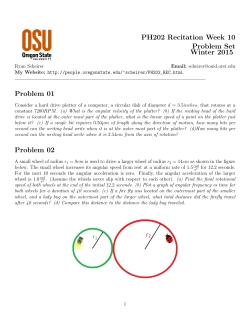
Document 108518
15. (II) A small rubber wheel is used to drive a large pottery
wheel, and they are mounted so that their circular edges
touch. If the small wheel has a radius of 2.0 cm and accelerates at the rate of 7.2 rad/s2, and it is in contact with the
pottery wheel (radius 25.0 cm) without slipping, calculate
(a) the angular acceleration of the pottery wheel, and
(b) the time it takes the pottery wheel to reach its required
speed of 65 rpm.
'
l
y ,re!,ÿ
:.:j"
&-- v'd,_
°" &
C
-
"ÿ t
¢%
j'
#,
....
"OS
23. (II) Calculate the net torque about the axle of the wheel
shown in Fig. 10 52. Assume that a friction torque of
0.30 m. N opposes the motion.
20Nÿ30N
FIGURE 10-52 Problem 23.
i¸ ÿ v ÿ
=,9ÿ ,
:4
a
,
I
.....
.........
:a;:
,,1
,
50N
/
24. (Iÿ) Determine the net torque on the 2.0-m-long beam
shown in Fig. 10-53. Calculate about (a) point C, the cÿ,
and (b) point P at one end.
60 N
C
P
/ •
I
50 N
, ÿ]' J
':z
....
FIGURE 10-53 Problem24.
Ptÿ
>,
j
...................
(
I# iii: ........
7. &
>,'#/
c ÿ-/
#
2
:
z
34. (IIÿ Four equal masses M are spaced at equal intervals, I,
/'along a horizontal straight rod whose mass can be ignored.
./- The system is to be rotated about a vertical axis passing
through the mass at the left end of the rod and perpendicu-
lar to it. (a) What is the moment of inertia of the system
about this axis? (b) What minimum force, applied to the farthest mass, will impart an angular acceleration a? (c) What
is the direction of this force?
/
Y
S-%ÿ%: ! g
59. (1I) A 4.8-m-diameter merry-goÿround is rotating ÿeely with
an angular ve!ocity ol 0.80 rad/s. Its total moment of inertia
is 1950 kg. m2. Four people standing on the ground, each of
65-kg mass, suddenly step onto the edge of the merry-goround. What is the angular velocity of the merry-go-round
i
now? What if the people were on it iÿitially and then jumped
off in a radial direction (relative to the merry-go-round)?
l"¸
?
.........
/
\
/
iÿ, 'ÿ'ÿ ...... ,.,{r
/
,¢
.....
lÿ'¸
,,ÿ
ÿ'ÿ
,ÿ:• ÿ
:/'ÿ Hÿ••• :•uÿ¸ÿ¸
•:ÿ:ÿ¸
9ÿ. A uniform disk turns at 7.0 rev/s around a frictionless spinJ die. A nonrotating rod, of the same mass as the disk and
length equal to the disk's diameter, is dropped onto the
reety spirming disk. They then both mrn around the spindle
with their centers superposed, Fig. 10-67. What is the angu-
lar velocity in rev/s of the combination?
FIGURE 10-67
Problem 96.
i
J
2¸
ÿ h/t
ÿ'ÿ
"2
J
,i'¸
]_
,f
/
6.3 A ring of mass M and radius R lies on its side on a fMct[onless
table. It is pivoted to the table at its rim. A bug of mass nÿ walks
around the ring with speed v, starting at the pivot. What is the rotational velocity of the ring when the bug is (a) hÿ31fway around and (b)
back at the pkot,
Ans. clue. (a) If tzÿ = M, ¢ÿ = v/'31ÿ
<
....
O14
A
:;=3 coJ/ ,
/
r
Mÿÿ ÿ .-
2. ÿ4ÿÿ
m
(ÿ
r
"ÿ-a
)
/L(.ÿ.z..,)
B
"
1
6.14 A uniform stick of massl]! and length lis suspended horizontally
with end B on the edge of a table, and the other end, 4 is held by hand,
PointA issuddeniy released, At the instant after release:
a. What [s the torque about B?
b, What is the angular acceleration about B?
c, What is the vertical acceTeration of the center of mass?
d, From part c, find by inspection the vertical force at ]?,
,ÿzJ'-
.L
olt:tÿ.,.
t4Z
2L
)
© Copyright 2025




















![Exercise 9.10 Exercise 9.24 Ch 9 Supplemental Problems [ Edit ]](http://cdn1.abcdocz.com/store/data/001596995_1-e35f6a6047fc419098203dc1b9e1a861-250x500.png)
